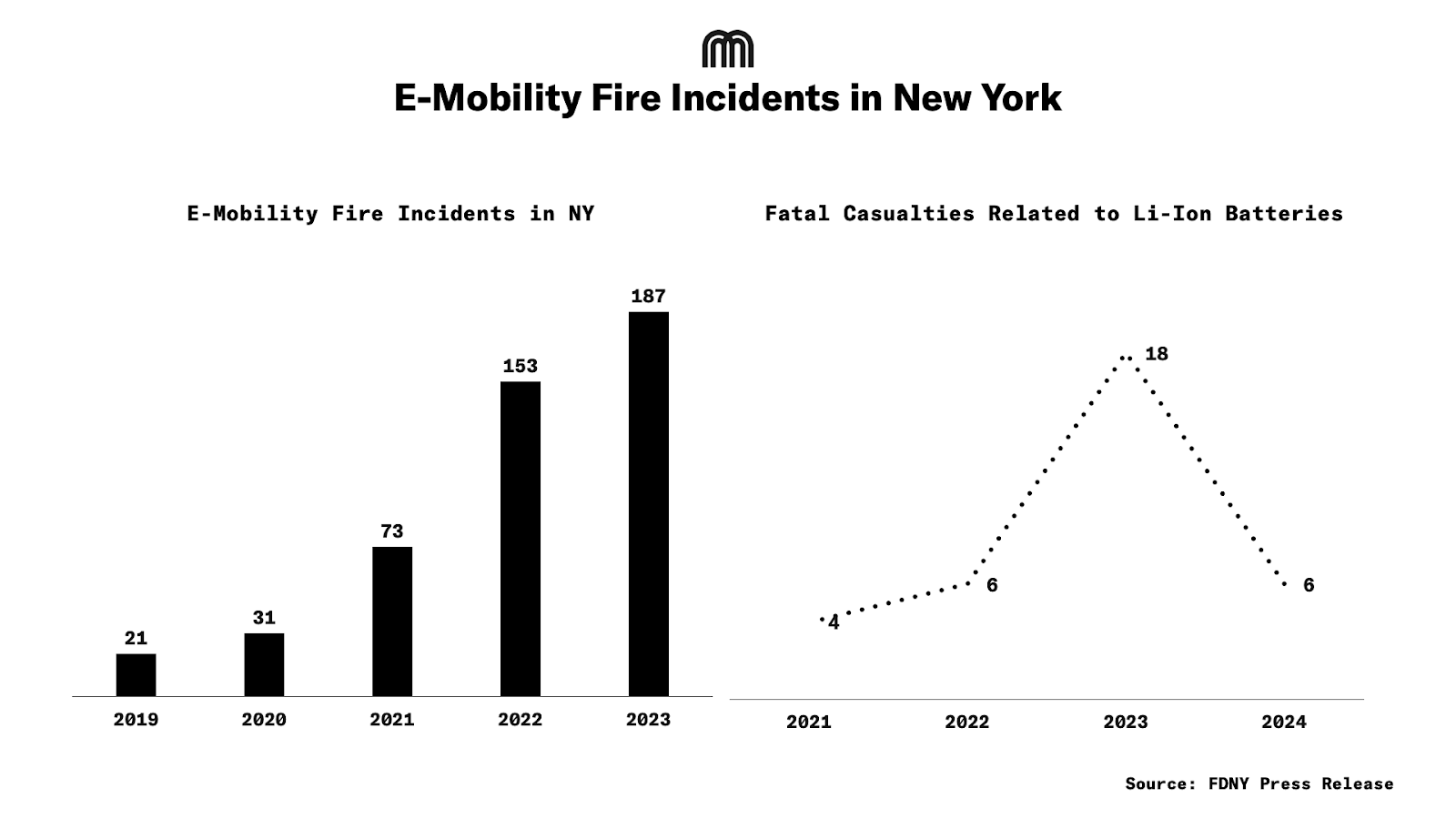On Monday, the embattled Rad Power was hit with another bit of controversy as a U.S. federal watchdog urged consumers to stop using certain models of the company’s e-bike batteries.
While an intriguing story by itself, this news opens up a debate about the role of regulating bodies in micromobility and what constitutes acceptable risk in new technologies. Before we arrive there though, let’s take a step back and look at the story in question.
On November 24, the Consumer Product Safety Commission (CPSC) published a release urging people to stop using lithium-ion batteries with the model numbers RP-1304 and HL-RP-S1304 because they “pose a risk of serious injury and death.”
Specifically, the CPSC states that the batteries can “unexpectedly ignite and explode,” especially in situations where they have been exposed to water and debris. The watchdog says it’s aware of 31 reports of battery fires, alongside 12 reports of property damage.
The Rad Power e-bikes impacted by this statement are:
- RadWagon 4
- RadCity HS 4
- RadRover High Step 5
- RadCity Step Thru 3
- RadRover Step Thru 1
- RadRunner 2
- RadRunner 1
- Radrunner Plus
Despite this strong statement from the CPSC, the e-bike manufacturer didn’t take it lying down.
The Rad Power pushback
In an announcement posted to its website, Rad Power rebuffed the CPSC’s warning, standing behind the safety of its batteries and fundamentally disagreeing with the assessment of them as either defective or unsafe.
“We have a long and well-documented track record of building safe, reliable ebikes equipped with batteries that meet or exceed rigorous international safety standards, including UL 2271 and UL 2849,” the company says.
UL 2271 and UL 2849 are certifications for ebikes crafted by Underwriters Laboratories (UL), a global private safety company. In regards to these specifications themselves, UL 2271 covers the lithium-ion battery pack, while UL 2849 is a standard that covers the entire electrical system, ranging from the battery and motor, to the charger and wiring.
The company’s statement continues, claiming that “reputable, independent third-party labs tested [its] batteries,” both in the product testing stages and the CPSC investigation, with the results “confirming compliance.”
Rad Power claims that the incidence rate of the battery fires is “a fraction of one percent” and implies user error as the cause of the problems. In particular, activities that contravened its guidelines, such as “significant water exposure.”
The CPSC statement comes at a bad time for Rad Power. Despite being a key driver of the U.S. electric bike boom, it has struggled as market conditions and investor sentiment shifted post-pandemic. This led to Rad filing a notice at the start of November warning employees of a potential permanent closure on January 9, 2026.
In a statement issued exclusively to Micromobility Industries, the company said that “we are not at the end of Rad’s story.” Their goal is to “[explore] every viable option to preserve the brand and the community that helped build it.”
This could be one reason why the company reacted so strongly to the CPSC’s warning. The agency asked for a product recall, but Rad Power declared that the “significant cost” of this “would force Rad to shut its doors immediately, leaving no way to support our riders or our employees.”
At the time of writing, the two are in a standoff — and this can be seen as a reflection of the industry itself.
The fight against fiery batteries
It’s not difficult to see why the CPSC is trying to do something about battery fires. Let’s consider a single city: New York.
Here, fires caused by the batteries of micromobility devices rose from 44 in 2020, to 220 in 2022. Because these fires are severe and difficult to extinguish, they can also prove deadly, with e-micromobility batteries being responsible for 18 fatalities in 2023 in the city.
New York has taken action against this. The city’s fire department started a Lithium-ion Battery Task Force which inspected 585 ebike shops in 2024, which led to “426 FDNY Summons, 138 violation orders, 32 criminal summonses, and … seven vacate orders.”
On top of this, New York also enacted Introduction 30, also known as the "Safe Delivery Device Access" law. With delivery drivers among the biggest users of e-bikes in the city, this aims to make e-bikes safer in the city, and is already having a big impact.

These figures are only for New York, similar incidents are occurring across the country. This puts pressure on bodies like the CPSC to act. In fact, Rad Power isn’t the first e-mobility company to be focused on by the agency.
The CPSC issued a similar warning for batteries sold under the Unit‑Pack Power (UPP) name due to the risks of fires and burn injuries. The agency also warned consumers to stop using FENGQS e-bikes for the same reason, specifically because of defective battery design and manufacturing.
What makes the Rad Power warning different is the scale. The company is one of the world’s leading e-bike brands and has a huge number of units out on the market.
Brandon Schuh — the head of specialty insurance at Christensen Group — posted about this specific topic. He stated that “each generation of CPSC regulators has [their blinders on] when it comes to how product engineering works along with the propensity (based on volume) for claims.”
According to Schuh, according to filings, there are like “more than one million products sold by RadPower.” Continuing with this maths, Schuh says that 31 battery fire incidents over that many e-bikes sold is a rate of “0.0031%.”
An industry-defining standoff
At the time of writing, neither side is backing down, with each side confident in their viewpoint.
For the CPSC, there’s clear evidence of danger, with battery fires from Rad Power e-bikes alone responsible for “property damage totaling approximately $734,500.” Rad Power, on the other hand, views this as a rare occurrence which only happens when their products are being misused.
The question is one of technology and is a worrying point at the heart of micromobility: where’s the line between consumer behaviour and acceptable risk?
As a society, we have reached a point where many are comfortable with the dangers of car travel, but as micromobility is a young industry driven by new technologies, that line is still being drawn.
It’s paradoxical. We agree that potentially harmful technologies are bad, but most of us also agree that an approximate incidence rate of 0.0031% is miniscule. Something should be done to make e-bike batteries safer, but independent regulators have declared these specific e-bike batteries safe. There’s a logic gap we can’t quite cross.
This issue won’t be solved overnight. Instead, it will be a long, drawn-out process, one in which regulators, safety agencies, and companies will bump heads for years to come. And the CPSC and Rad Power standoff? Well, that’s simply another chapter in this ongoing story.
Image Credits: Rad Power Bikes

.svg)
%2Bcopy.jpeg)


.svg)












